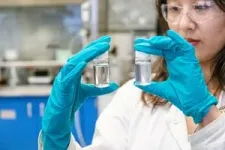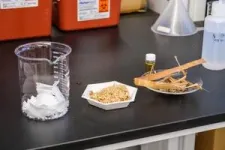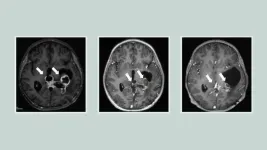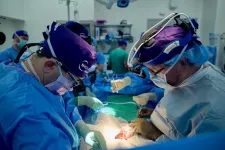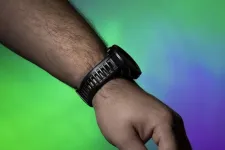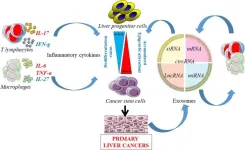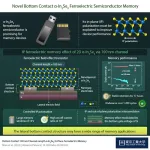(Press-News.org) Could plants be the answer to the looming threat of microplastic pollution? Scientists at UBC’s BioProducts Institute found that if you add tannins—natural plant compounds that make your mouth pucker if you bite into an unripe fruit—to a layer of wood dust, you can create a filter that traps virtually all microplastic particles present in water.
While the experiment remains a lab set-up at this stage, the team is convinced that the solution can be scaled up easily and inexpensively once they find the right industry partner.
Microplastics are tiny pieces of plastic debris resulting from the breakdown of consumer products and industrial waste. Keeping them out of water supplies is a huge challenge, says Dr. Orlando Rojas, the institute’s scientific director and the Canada Excellence Research Chair in Forest Bioproducts.
He noted one study which found that virtually all tap water is contaminated by microplastics, and other research which states that more than 10 billion tons of mismanaged plastic waste will be dispersed in the environment by 2025.
“Most solutions proposed so far are costly or difficult to scale up. We’re proposing a solution that could potentially be scaled down for home use or scaled up for municipal treatment systems. Our filter, unlike plastic filters, does not contribute to further pollution as it uses renewable and biodegradable materials: tannic acids from plants, bark, wood and leaves, and wood sawdust—a forestry byproduct that is both widely available and renewable.”
Captures a wide variety of plastics
For their study, the team analyzed microparticles released from popular tea bags made of polypropylene. They found that their method (they’re calling it “bioCap”) trapped from 95.2 per cent to as much as 99.9 per cent of plastic particles in a column of water, depending on plastic type. When tested in mouse models, the process was proved to prevent the accumulation of microplastics in the organs.
Dr. Rojas, a professor in the departments of wood science, chemical and biological engineering, and chemistry at UBC, adds that it’s difficult to capture all the different kinds of microplastics in a solution, as they come in different sizes, shapes and electrical charges.
“There are microfibres from clothing, microbeads from cleansers and soaps, and foams and pellets from utensils, containers and packaging. By taking advantage of the different molecular interactions around tannic acids, our bioCap solution was able to remove virtually all of these different microplastic types.”
Collaborating on sustainable solutions
The UBC method was developed in collaboration with Dr. Junling Guo, a professor at the Center of Biomass Materials and Nanointerfaces at Sichuan University in China. Marina Mehling (she/her), a PhD student at UBC’s department of chemical and biological engineering, and Dr. Tianyu Guo (she/her), a postdoctoral researcher at the BioProducts Institute, also contributed to the work.
“Microplastics pose a growing threat to aquatic ecosystems and human health, demanding innovative solutions. We’re thrilled that the BioProducts Institute’s multidisciplinary collaboration has brought us closer to a sustainable approach to combat the challenges posed by these plastic particles,” said Dr. Rojas.
Interview language(s): English (Rojas, Tianyu Guo, Mehling), Mandarin (Tianyu Guo)
Multimedia assets:
Link to study
Dropbox (images and b-roll)
Related links:
Learn more about the BioProducts Institute
UBC microplastics cluster symposium highlights groundbreaking research and discussions on microplastic pollution
UBC entrepreneurs join fight against plastic pollution END
Microplastic pollution: Plants could be the answer
UBC device uses wood dust to trap up to 99.9 per cent of microplastics in water
2023-08-16
ELSE PRESS RELEASES FROM THIS DATE:
Directly involved war veterans exhibit nearly twice the PTSD symptoms years after 2014 Israel-Gaza conflict, affecting parents' well-being
2023-08-16
Hebrew University researchers, Shahaf Leshem, Eldad Keha, and Prof. Eyal Kalanthroff, have unveiled significant findings regarding the lasting psychological impacts stemming from the 2014 Israel-Gaza military conflict. The study sheds light on the deep repercussions of trauma for both war veterans and their parents. Notably, veterans directly involved in the conflict exhibited nearly twice the level of PTSD symptoms compared to indirectly active veterans, a difference persisting even five years after the conflict. Remarkably, ...
Study finds improved survival for incurable brain tumor, providing ‘a crack in the armor’
2023-08-16
Michigan — For the first time, researchers have found a potential drug candidate that improved outcomes for patients with a type of childhood brain tumor for which there are no effective treatments. The compound, called ONC201, nearly doubled survival for patients with diffuse midline glioma (DMG) or diffuse intrinsic pontine glioma (DIPG), compared to previous patients.
The findings are reported by an international team of researcher led by the University of Michigan Health Rogel Cancer Center and the Chad Carr Pediatric Brain Tumor Center.
In addition to reporting on the results of two early stage clinical ...
Pig kidney xenotransplantation performing optimally after 32 days in human body
2023-08-16
NEW YORK, NY, AUGUST 16, 2023 — Surgeons at NYU Langone Health have transplanted a genetically engineered pig kidney that continues to function well after 32 days in a man declared dead by neurologic criteria and maintained with a beating heart on ventilator support. This represents the longest period that a gene-edited pig kidney has functioned in a human, and the latest step toward the advent of an alternate, sustainable supply of organs for transplant.
Multimedia Materials Available
Multimedia materials, including photos and a B-roll package, are available for download.
About the Procedure
The procedure, performed on July 14, 2023, and led by Robert Montgomery, ...
ASBMB names 2024 award winners
2023-08-16
The American Society for Biochemistry and Molecular Biology announced today the winners of its annual awards. Colleagues and other leaders in the field nominated the winners for making significant contributions to biochemistry and molecular biology and the training of emerging scientists.
The recipients will give talks about their work at the society’s 2024 annual meeting, Discover BMB, slated for March 23–26 in San Antonio.
In addition to cash prizes ranging from $2,000 to $35,000, each ASBMB award consists of a plaque and transportation ...
New and updated resources published to help guide oncology care in the Middle East and North Africa (MENA)
2023-08-16
PLYMOUTH MEETING, PA [August 16, 2023] — The National Comprehensive Cancer Network® (NCCN®)—an alliance of leading cancer centers—today announced that a library of resources for improving cancer care in the Middle East and North Africa (MENA) has been updated and expanded in collaboration with regional experts. The United States-based non-profit has worked with the King Abdulaziz Medical City in Riyadh, Saudi Arabia, since 2015 to standardize cancer treatment based on the latest evidence and expert-consensus, as part of the MENA-NCCN Regional Coordinating Center. Their efforts have led to the ...
Gray wolf recovery is a success—is that a problem?
2023-08-16
Over the past 30 years, efforts to recover gray wolf populations in the United States have been broadly successful, with many regions now sporting robust populations of the charismatic carnivore. Writing in BioScience, wolf experts David E. Ausband and L. David Mech describe the conservation landscape and also the obstacles that wolves face as their populations expand into their historical ranges.
"Remarkable wolf conservation success yields remarkable challenges," ...
Common wristbands ‘hotbed’ for harmful bacteria including E. coli, staphylococcus
2023-08-16
The COVID-19 pandemic took disinfecting to new heights. Now, a new study examining a commonly used item might convince you not to let your guard down just yet.
Researchers from Florida Atlantic University’s Charles E. Schmidt College of Science tested wristbands of various textures to determine their risk for harboring potentially harmful pathogenic bacteria. Despite being worn daily, routine cleaning of wristbands is generally overlooked or simply ignored.
For the study, researchers tested plastic, rubber, cloth, leather ...
What is the next step in preventative therapies for treating liver cancer?
2023-08-16
Primary liver cancers ranked as the sixth most commonly diagnosed cancers and the third leading cause of cancer-related death in 2020. Among all primary liver cancers, HCC is the most common cancer, accounting for more than 80% of cases with a 5-year survival rate of less than 10% in Western countries. Despite significant progress in diagnosis and treatments, HCC, often diagnosed at late stages, remains a life-threatening disease with an increasing incidence. Therefore, a better understanding of the underlying mechanisms triggering the early steps of tumorigenesis represents a great interest to predict and propose more effective therapeutic ...
Layered and traditional semiconductors heterogenous integration open door for post Moore era
2023-08-16
Scientists in NEXT Lab, Tsinghua University have revealed the fabrication and engineering techniques of TMDs and provided a comparative view between TMDs and traditional semiconductors, demonstrating the benefit of combining TMDs with traditional semiconductors.
The research, published in IJEM, shows how to fabricate layered semiconductors modulated with various methods, including phase engineering, defect engineering, doping, and alloying. Then the authors discuss various possibilities to combine layered semiconductors with traditional semiconductors.
Transition metal dichalcogenides (TMDs) with suitable ...
Novel lateral data storage: Two-dimensional ferroelectric semiconductor memory with a bottom contact 100 nm channel using in-plane polarization
2023-08-16
Traditional memory technologies face limitations in terms of speed, scalability, and power consumption, making them unsuitable for future data-intensive applications. Ferroelectric memory has garnered immense interest in recent years due to its potential for non-volatile storage, enabling data retention even when the power is turned off. The development of two-dimensional (2D) van der Waals material α-In2Se3 has also opened new opportunities for advancing memory technologies.
Interestingly, ferroelectric memory takes a giant step forward by incorporating the remarkable properties ...
LAST 30 PRESS RELEASES:
Scientists trace microplastics in fertilizer from fields to the beach
The Lancet Obstetrics, Gynecology, & Women’s Health: Taking paracetamol during pregnancy does not increase risk of autism, ADHD or intellectual disabilities, confirms new gold-standard evidence review
Taking paracetamol during pregnancy does not increase risk of autism, ADHD or intellectual disabilities
Harm reduction vending machines in New York State expand access to overdose treatment and drug test strips, UB studies confirm
University of Phoenix releases white paper on Credit for Prior Learning as a catalyst for internal mobility and retention
Canada losing track of salmon health as climate and industrial threats mount
Molecular sieve-confined Pt-FeOx catalysts achieve highly efficient reversible hydrogen cycle of methylcyclohexane-toluene
Investment in farm productivity tools key to reducing greenhouse gas
New review highlights electrochemical pathways to recover uranium from wastewater and seawater
Hidden pollutants in shale gas development raise environmental concerns, new review finds
Discarded cigarette butts transformed into high performance energy storage materials
Researchers highlight role of alternative RNA splicing in schizophrenia
NTU Singapore scientists find new way to disarm antibiotic-resistant bacteria and restore healing in chronic wounds
Research suggests nationwide racial bias in media reporting on gun violence
Revealing the cell’s nanocourier at work
Health impacts of nursing home staffing
Public views about opioid overdose and people with opioid use disorder
Age-related changes in sperm DNA may play a role in autism risk
Ambitious model fails to explain near-death experiences, experts say
Multifaceted effects of inward foreign direct investment on new venture creation
Exploring mutations that spontaneously switch on a key brain cell receptor
Two-step genome editing enables the creation of full-length humanized mouse models
Pusan National University researchers develop light-activated tissue adhesive patch for rapid, watertight neurosurgical sealing
Study finds so-called super agers tend to have at least two key genetic advantages
Brain stimulation device cleared for ADHD in the US is overall safe but ineffective
Scientists discover natural ‘brake’ that could stop harmful inflammation
Tougher solid electrolyte advances long-sought lithium metal batteries
Experts provide policy roadmap to reduce dementia risk
New 3D imaging system could address limitations of MRI, CT and ultrasound
First-in-human drug trial lowers high blood fats
[Press-News.org] Microplastic pollution: Plants could be the answerUBC device uses wood dust to trap up to 99.9 per cent of microplastics in water

